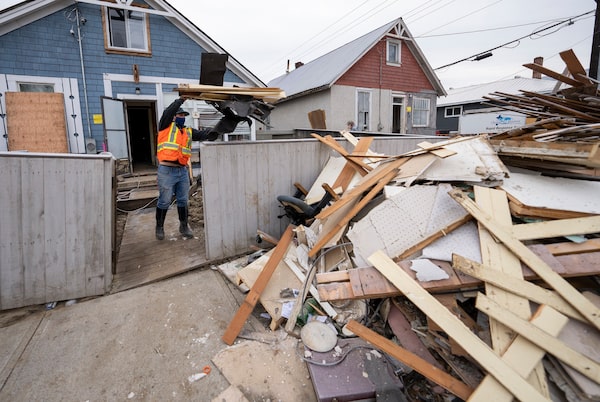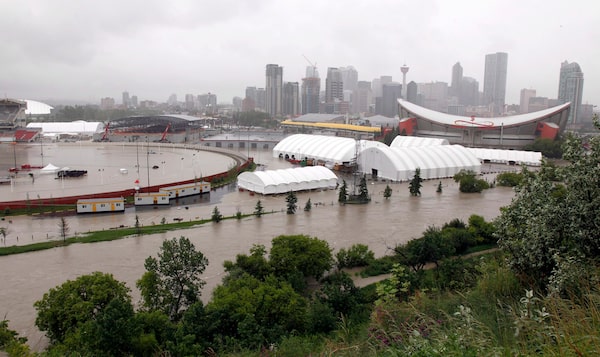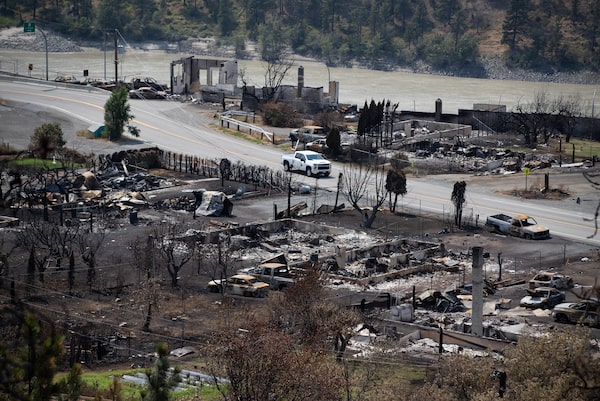
A worker collects contents from the insides of homes that were flooded in downtown Princeton, B.C., on Dec. 3, 2021. Princeton, like many parts of the province, was hit with heavy floods and mudslides last month, causing major devastation.JONATHAN HAYWARD/The Canadian Press
The storms that battered British Columbia in November left taxpayers on the hook for billions of dollars because few homeowners had overland flood insurance.
A new report commissioned by Public Safety Canada says the country urgently needs to ensure such insurance is widely available, as climate change increases the risks of ever-greater disasters.
“Underinsurance creates large liabilities for governments who ultimately bear many of these costs; not only must they rebuild public infrastructure, but they are also called upon to provide relief to individuals and businesses,” notes the report, Building a Resilient Canada, released Thursday by an expert panel from the Council of Canadian Academies.
Were B.C.’s dikes ever up to the job of stopping floods like these?
Do you need flood insurance? As deluges become more common, here’s what home owners should know
In December, Ottawa promised an initial $5-billion payment for disaster relief to British Columbia to help pay for the November storm damage. By comparison, the insurance industry expects to pay out $515-million for claims related to the storms.
Canada’s underinsurance challenge was exacerbated by the 2013 Calgary floods. The floods caused $5-billion in damages, and insurers covered $1.8-billion of that total. That massive payout prompted the industry to create a defined product – residential overland flood coverage – starting in 2015.
The relatively new flood insurance option is not widely available, however. As of 2021, only one insurer offered coverage in Canada for overland flooding in high-risk areas, such as the Sumas Prairie in Abbotsford where more than 1,000 homes were evacuated in mid-November after a series of atmospheric rivers that caused flooding and highway washouts across southern B.C.

The Calgary Stampede grounds are flooded due to heavy rains in the city on June 21, 2013. The floods caused $5-billion in damages, and insurers covered $1.8-billion of that total. That massive payout prompted the industry to create a defined product – residential overland flood coverage – starting in 2015.Jeff McIntosh/The Canadian Press
The expert panel suggests the federal government should be a partner in developing and funding a more accessible flood insurance program, which it argues will help save money in the long run.
“Canada is a bit of an outlier,” said Scott Vaughan, chair of the panel and a senior fellow with the International Institute for Sustainable Development. He said many advanced economies offer some form of nationalized flood insurance.
According to the Toronto-based Catastrophe Indices and Quantification Inc., insurers will pay out more than $2-billion for climate-related catastrophes in Canada in 2021 – and one-third of that will be for claims in British Columbia. The Insurance Bureau of Canada has been in talks with the provinces and the federal government about developing an affordable flood insurance product for all homeowners for several years, without a resolution.

A person walks a dog in a residential neighbourhood in Abbotsford, B.C., on Dec. 1 as flooded farmland lies in the distance.DARRYL DYCK/The Canadian Press
“The hold-up is on the government’s end, it’s not a politically sexy topic,” said Kathryn Hyland, a member of the expert panel who was an executive in the insurance industry.
She said the report aims to encourage government to finally reach an agreement. “It’s something the industry is highly supportive of,” she said. “It’s really sad that it takes a disaster to get government’s attention.”
More broadly, the report concludes that Canada needs to invest in disaster prevention measures that account for climate change, or expect to pay ever-increasing costs for disaster response and recovery.
“Land-use decisions, population growth and rapid economic development have greatly increased the exposure of populations, driving up the cost of losses over the last few decades,” the report says. “Climate change is altering the frequency, severity and distribution of natural hazards, further exacerbating risk.”
Mr. Vaughan said British Columbia’s extreme weather events in 2021, from the heat dome that killed hundreds, to the wildfires that wiped out the town of Lytton, and then the catastrophic November rainstorms, should provide all the evidence Canada needs to act.

An RCMP vehicle drives past the remains of vehicles and structures in Lytton, B.C., on July 9, 2021, after a wildfire destroyed most of the village on June 30. The Insurance Bureau of Canada, in August last year, estimated the damage caused by the wildfire is $78-million.DARRYL DYCK/The Canadian Press
“We know plenty now about the changing risk of extreme climate events, and we don’t need any more evidence than 2021,” he said.
Another member of the panel, Mike Flannigan, is a fire and climate expert at Thompson Rivers University in Kamloops, where smoke from last summer’s wildfires was unavoidable and the November floods cut off access to the Lower Mainland. The impact of those events, he said, should be a catalyst for new investments not only in climate-resistant buildings and infrastructure, but also in better data and research.
“Sometimes you need a bloody nose or two, before you actually get the discipline to change. We’ve had our bloody nose, so now it’s time to change.”
From fire to ‘atmospheric river’: Why B.C. is trapped in a world of climate extremes
Dr. Flannigan said Canada is hampered by data gaps, such as up-to-date flood maps. The task force calls for the creation of a publicly available, integrated, all-hazard risk assessment, so people understand risks and governments can be strategic in investing resources where they could have the greatest possible benefit.
”I hope 2022 is less disastrous for British Columbia, and for Canada,” Dr. Flannigan said. “That’s what my heart holds. But my head says likely more than not, we’ll have more disasters this year and they could be bad or even worse than previous year. Which is scary.”
Climate Scientist and Professor Simon Donner explains what the phenomenon 'atmospheric river' is and why the one that hit Western Canada dumped record breaking amounts of rain in the Lower Mainland of British Columbia.
We have a weekly Western Canada newsletter written by our B.C. and Alberta bureau chiefs, providing a comprehensive package of the news you need to know about the region and its place in the issues facing Canada. Sign up today.
 Justine Hunter
Justine Hunter